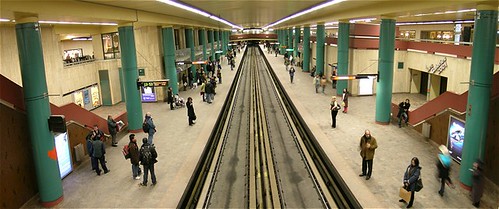The McGill Metro stop in Montreal was literally falling down this weekend (Photo by flickr user blork)
Subways all over the globe had issues this weekend, and after yesterday’s post noting the problems in China and Washington, DC, my readers were more than happy to share their experiences in subway systems that just can’t measure up to New York’s.
The best tip came from Greg who e-mailed me about the problems in Montreal. On Friday, officials shut down the McGill Metro stop in Montreal when two large cracks were discovered in the tunnels linking the subway station to a nearby mall. That sounds like fun. CBC News had more:
Police emptied buildings and sealed off a large section of Montreal’s downtown core for the weekend, and service was cancelled on part of one subway line after two fissures in a tunnel linking the McGill station to malls were discovered Friday…
Fearing that roads could collapse, Montreal police cleared several city blocks of people in an area bordered by Sherbrooke, St. Catherine and Bleury streets and University Avenue, and shut the streets to traffic.
With a major university laying claim to this subway stop, New Yorkers can imagine this infrastructure issue happening right here in the playground that is the West Village. Imagine if deep fissures appeared in the ceiling at the West 4th St. stop (which is not hard to picture if you’ve looked closely at that station lately). Not only would the city be collectively flipping out, but service on up to 8 subway lines would be messed up.
So as the week rolls on and the State Comptroller tells us that the MTA doesn’t really need that fare hike, we can yet again be grateful that the tracks aren’t catching fire as they are in Washington, D.C., and that the sky — or ceiling — isn’t falling like it is in Montreal. Yet.


 The Comptrollers are revolting. (Well, then, maybe they should shower. I’ll be here all week.)
The Comptrollers are revolting. (Well, then, maybe they should shower. I’ll be here all week.) On Sunday afternoon, I headed off from Brooklyn to the Charlie Parker Jazz Festival in Alphabet City’s Tompkins Square Park. Generally, the best way for to go is via the F train to 2nd Ave. It’s a short walk from 1st Ave. and Houston to Tompkins Square.
On Sunday afternoon, I headed off from Brooklyn to the Charlie Parker Jazz Festival in Alphabet City’s Tompkins Square Park. Generally, the best way for to go is via the F train to 2nd Ave. It’s a short walk from 1st Ave. and Houston to Tompkins Square.




 Leave it to amNY to bury the lead. In an
Leave it to amNY to bury the lead. In an